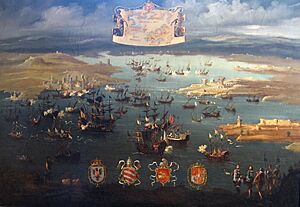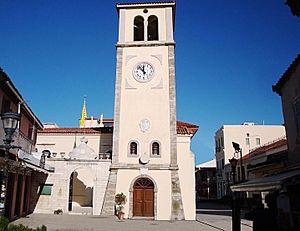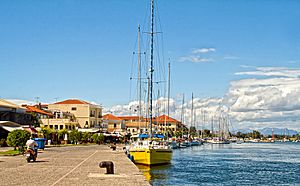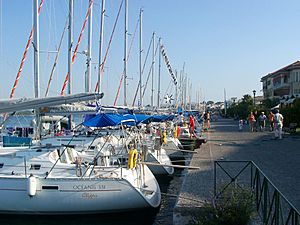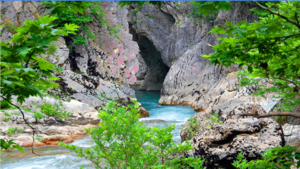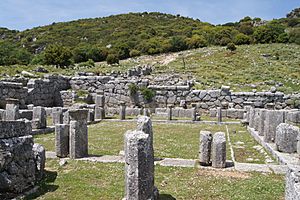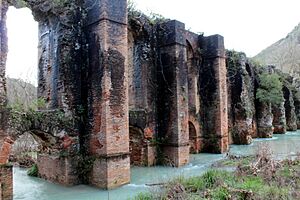Preveza facts for kids
Quick facts for kids
Preveza
Πρέβεζα
|
|
|---|---|

The promenade and port
|
|
| Country | Greece |
| Administrative region | Epirus |
| Regional unit | Preveza |
| Area | |
| • Municipality | 380.5 km2 (146.9 sq mi) |
| • Municipal unit | 66.8 km2 (25.8 sq mi) |
| Elevation | 8 m (26 ft) |
| Population
(2021)
|
|
| • Municipality | 30,841 |
| • Municipality density | 81.054/km2 (209.929/sq mi) |
| • Municipal unit | 22,868 |
| • Municipal unit density | 342.34/km2 (886.6/sq mi) |
| Demonym(s) | Prevezian |
| Community | |
| • Population | 21,099 (2021) |
| Time zone | UTC+2 (EET) |
| • Summer (DST) | UTC+3 (EEST) |
| Postal code |
481 00
|
| Area code(s) | 26820 |
| Vehicle registration | ΡΖ |
Preveza (Greek: Πρέβεζα) is a city in northwestern Greece. It's located in the Epirus region, right at the entrance of the Ambracian Gulf. Preveza is the main city of the Preveza regional unit.
A special underwater tunnel, the Aktio-Preveza Undersea Tunnel, connects Preveza to Aktio on the southern side. This tunnel, finished in 2002, is the first and only one of its kind in Greece. The ancient city of Nicopolis is also very close, about 7 kilometers north of Preveza.
Contents
- What Does the Name Preveza Mean?
- How the Municipality of Preveza is Organized
- A Look Back in Time: Preveza's History
- Ancient Times: Battles and Great Cities
- Medieval Period: A Name Appears
- First Ottoman Period: A Naval Battle
- Venetian Control: Trade and Schools
- A Year of French Rule (1797–1798)
- Second Ottoman Period: Education and Politics
- Balkan Wars: Joining Greece
- Second World War: A Difficult Time
- Preveza Today: A Modern Hub
- Places to See in Preveza
- Famous People from Preveza
- Getting Around Preveza
- Population Changes Over Time
- Preveza's International Friends
- Images for kids
- See also
What Does the Name Preveza Mean?
The name Preveza was first written down in a book called the Chronicle of the Morea around 1290. Most people believe the name comes from a Slavic word, prěvozъ, which means 'passage' or 'crossing'.
This word likely came into Greek through the Albanian word prevëzë, also meaning 'transportation' or 'crossing'. This makes sense because Preveza is located at a narrow point, perfect for crossing.
How the Municipality of Preveza is Organized
The way the Municipality of Preveza is set up today was decided in 2011. This happened when three smaller former municipalities joined together. These smaller areas became what are now called Municipal Units.
The total area of the municipality is about 380.5 square kilometers.
A Look Back in Time: Preveza's History
Ancient Times: Battles and Great Cities
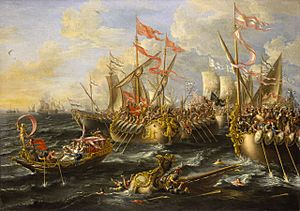
Long ago, the southern part of Epirus was home to a Greek tribe called the Cassopeans. Their main city was Cassope, near today's Kamarina village.
Around 290 BC, King Pyrrhus founded a town called Berenike (or Berenice). He named it after his mother-in-law. Today, we think Berenike was located on the hills near Michalitsi village.
The Famous Battle of Actium
The sea near Berenike was the site of a very important naval battle. This was the Battle of Actium on September 2, 31 BC. In this battle, Octavian's forces defeated the armies of Mark Antony and Queen Cleopatra of Egypt.
To celebrate his victory, Augustus built a new city nearby called Nicopolis, which means "Victory City." At its busiest, Nicopolis may have had 150,000 people! Later, in 90 AD, the famous philosopher Epictetus came to Nicopolis and started a school of philosophy there.
Medieval Period: A Name Appears
The name Preveza first appeared in records in 1292. At that time, allies of the Byzantine emperor raided its port. However, the city itself might have been founded earlier, perhaps after the ancient city of Nicopolis was abandoned around the 1060s.
For a long time after this, Preveza isn't mentioned much, suggesting it was either very small or even abandoned. The modern city likely started to grow and was fortified around 1477, and again in 1495. This means Preveza is probably not a direct continuation of ancient Nicopolis.
The Ottomans rebuilt Preveza around 1477 and made its defenses stronger in 1495. A very important naval battle, the Battle of Preveza, took place off its coast on September 29, 1538.
In this battle, the Ottoman fleet, led by Hayreddin Barbarossa, defeated a combined Christian fleet. This day is still a national holiday for the Turkish Navy today.
Venetian Control: Trade and Schools
Preveza was often fought over during the wars between the Ottomans and the Venetians. In 1684, the Venetians captured Preveza, but they had to give it back in 1699.
They captured it again in 1717 and managed to keep it this time. Venetian rule lasted until 1797. During this time, in 1779, a missionary named Kosmas visited Preveza. He is said to have started a Greek school there. By the late 1700s, Preveza became a busy trading center with Western Europe, and its population grew to about 10,000 to 12,000 people.
A Year of French Rule (1797–1798)
After the Venetian Republic ended, Preveza was given to Revolutionary France in 1797. French soldiers arrived and were welcomed by the people of Preveza, who even formed their own pro-French local army.
However, the French leader Napoleon Bonaparte was busy with other wars. In October 1798, the local Ottoman governor, Ali Pasha Tepelena, attacked Preveza with a huge army.
The Battle of Nicopolis and its Aftermath
In the Battle of Nicopolis on October 12, 1798, Ali Pasha's troops easily defeated the French and their local allies. Over the next two days, a terrible massacre happened in Preveza. Many French soldiers and local Greeks who defended the city were killed.
Ali Pasha tricked some citizens who had escaped into returning, only to have 170 of them executed. Many prisoners died on the way to Ioannina. This event, though sad, helped spark Greek nationalism and led to the Greek War of Independence later on.
Second Ottoman Period: Education and Politics
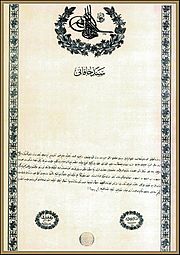
From 1798 to 1820, Preveza was ruled by the powerful Ali Pasha Tepelena. After his death, the city was controlled more directly by the Ottoman Empire. In 1835, education in Preveza started to thrive again with a new Greek school, the Theophaneios. This school became a major learning center.
In 1878, the Congress of Berlin decided that parts of southern Epirus, including Preveza, should become part of Greece. However, meetings between Greek and Ottoman representatives failed. Albanian leaders, like Abedin Dino, also played a role in these talks, opposing Preveza joining Greece.
Eventually, in 1881, a deal was made where Thessaly and Arta joined Greece, but most of Epirus, including Preveza, remained Ottoman. From 1881 to 1912, Preveza's economy struggled, but its schools continued to do well, supported by people like Anastasios Theofanis.
Balkan Wars: Joining Greece

Preveza remained under Ottoman control until the Greek Army took it on October 21, 1912, during the First Balkan War. This happened after the Battle of Nicopolis.
In 1913, Preveza officially became part of Greece through the Treaty of London. After these wars, Preveza's harbor became an important trading center in western Greece.
Second World War: A Difficult Time
During World War II, Preveza was occupied by Fascist Italy (1941–1943) and Nazi Germany (1943–1944). The city's Jewish community, which had 250 members, was sadly arrested and killed in Nazi death camps. Only 15 survived.
After the German army left in September 1944, a battle took place in Preveza during the Greek Civil War. This fight lasted 16 days between different Greek resistance groups.
Preveza Today: A Modern Hub
Today, Preveza is a busy commercial port and a popular place for tourists. It has a marina, museums, cinemas, and many places to eat and relax. It's close to the Aktion National Airport and the beautiful island of Lefkada, which is a big tourist spot.
The Aktio-Preveza Immersed Tunnel, opened in 2002, has made it much easier to travel to and from Preveza. It connects the city to Actium across the Ambracian Gulf. Preveza also has a university department and a Navy Academy.
Places to See in Preveza
Preveza and its surrounding area have many interesting historical sites and natural beauties to explore:
- Ancient Nicopolis area: You can see old walls, Roman baths, a theater, and the Augustus Monument.
- Ancient Cassope: An ancient city from 400 BC, about 25 kilometers from Preveza.
- Archaeological Museum of Nikopolis: A great place to learn about the history of Nicopolis.
- St. Charalampos Church: A historic church built between 1715 and 1793.
- Fortress of Pantocrator: A fortress from Ali Pasha's time (around 1810).
- Castle of Saint Andrew: An old castle with parts from Ottoman and Ali Pasha periods.
- Aktio-Preveza Undersea Tunnel: A modern engineering marvel, opened in 2002.
- Venetian clock tower of Preveza: A historic clock tower from the Venetian period.
- Monolithi beach: A long, beautiful beach and nearby forest.
Famous People from Preveza
Many notable people have come from Preveza:
- Odysseas Androutsos: A hero of the Greek War of Independence.
- Rae Dalven: An American scholar and translator.
- Abedin Dino: An important Albanian political figure.
- Ali Dino: A famous Albanian cartoonist.
- Theodoros Grivas: Another hero of the Greek War of Independence.
- Kleareti Malamou-Dipla: A poet and writer.
- Despina Papamichail: A tennis player.
- Athina Papayianni: An athlete.
- Thrasyvoulos Tsakalotos: A Greek Army chief.
- Athanasia Tsoumeleka: An Olympic gold medalist in fast running.
Getting Around Preveza
Preveza is connected by roads to other places like Igoumenitsa and Ioannina. The Aktio-Preveza Undersea Tunnel makes it easy to reach Aetolia-Acarnania in Central Greece.
The city also has a small port for trade and passengers. For air travel, the nearby Aktion National Airport serves Preveza and the island of Lefkada.
Population Changes Over Time
| Year | Community | Municipal unit | Municipality |
|---|---|---|---|
| 1981 | 13,624 | – | – |
| 1991 | 13,341 | 16,886 | – |
| 2001 | 17,724 | 19,605 | – |
| 2011 | 20,795 | 22,853 | 31,733 |
| 2021 | 21,099 | 22,868 | 30,841 |
Preveza's International Friends
Preveza is a founding member of the Douzelage. This is a special group of 24 towns across the European Union that are twinned with each other. They have regular events and festivals to connect their communities.
Preveza is twinned with towns from many different countries:
 Altea, Spain
Altea, Spain Bad Kötzting, Germany
Bad Kötzting, Germany Bellagio, Italy
Bellagio, Italy Bundoran, Republic of Ireland
Bundoran, Republic of Ireland Granville, France
Granville, France Holstebro, Denmark
Holstebro, Denmark Houffalize, Belgium
Houffalize, Belgium Meerssen, the Netherlands
Meerssen, the Netherlands Niederanven, Luxembourg
Niederanven, Luxembourg Sesimbra, Portugal
Sesimbra, Portugal Sherborne, United Kingdom
Sherborne, United Kingdom Karkkila, Finland
Karkkila, Finland Oxelösund, Sweden
Oxelösund, Sweden Judenburg, Austria
Judenburg, Austria Chojna, Poland
Chojna, Poland Kőszeg, Hungary
Kőszeg, Hungary Sigulda, Latvia
Sigulda, Latvia Sušice, Czech Republic
Sušice, Czech Republic Türi, Estonia
Türi, Estonia Zvolen, Slovakia
Zvolen, Slovakia Prienai, Lithuania
Prienai, Lithuania Marsaskala, Malta
Marsaskala, Malta Siret, Romania
Siret, Romania
Images for kids
See also
 In Spanish: Préveza para niños
In Spanish: Préveza para niños



